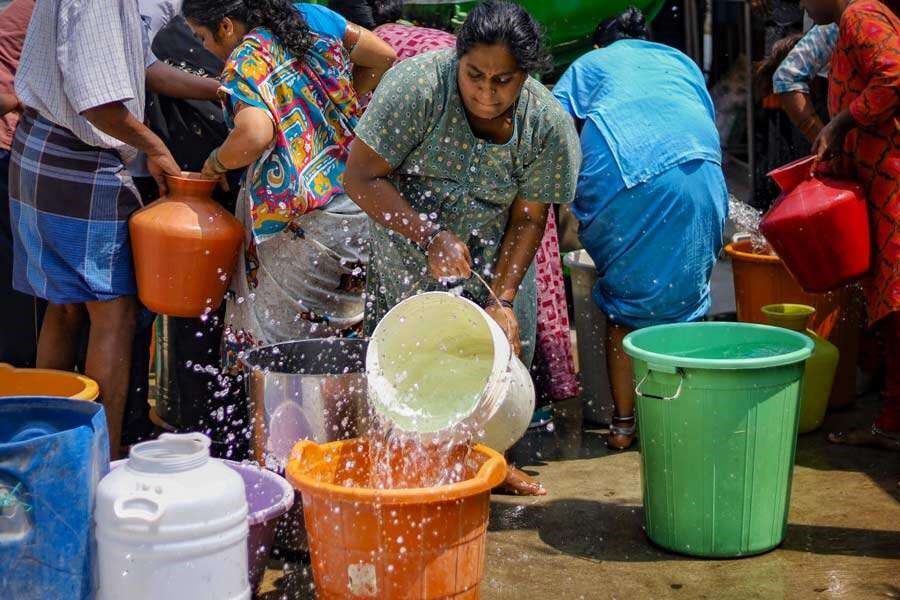Description

Disclaimer: Copyright infringement not intended.
Context
An acute drinking water crisis in Bengaluru has been creating international headlines for the past few days.
Details
The crisis
- The shortage of water is not restricted to Bengaluru, and neither is it only a drinking water problem.
- The entire state of Karnataka, as also the adjoining areas of Telangana and Maharashtra, are facing water scarcity.
- Much of this has to do with the lower-than-normal rainfall in this area in the last one year and the nature of underground aquifers in this region.
Reason for shortage
Deficit in the monsoon rain
- During last year’s monsoon, Karnataka received rainfall that was 18 per cent below normal, the least since 2015. Even the post-monsoon period did not bring much rain to the state.
- Like most other parts of the country, Karnataka receives a bulk of its annual rainfall during the monsoon, and it is this water that fills up the reservoirs and recharges the aquifers. A rainfall deficit in the monsoon months almost inevitably results in water stress.
Other states
- Karnataka was not the only state to receive below-normal rainfall last monsoon.
- Kerala, for example, finished the season with a 34 per cent deficit.
- Bihar, Jharkhand and eastern Uttar Pradesh had almost 25 per cent deficit each.
How different from north India
Nature of the underground aquifers.
- South India has a very different kind of aquifer system. It is very rocky. The aquifers don’t hold a lot of water. They empty out quickly, and they also get recharged pretty quickly.
- Means is that groundwater resources are not able to sustain for very long in the event of a prolonged dry spell.
- This is very different from the aquifers in north India, which have a much better capacity to hold wate This is why Bihar and Uttar Pradesh, which got even less rainfall last year than Karnataka, have not seen similar water scarcity.
- Aquifers in north India, once full, can hold enough water to sustain the demand for a couple of years

Falling reservoir levels
Low rainfall
- Another direct consequence of low rainfall has been the relatively low level of water in reservoirs.
- Latest data from the Central Water Commission shows that Karnataka reservoirs are currently holding water at only 26 per cent of their full capacity, which is at least ten percentage points lower than what is expected at this time of the year.
- Instead of the nearly 8.8 billion cubic meters of water that is expected in Karnataka’s reservoirs at this time of the year, only 6.5 billion cubic meters is currently available. And this is depleting steadily.
- A month earlier, the state’s reservoirs were holding 7.78 billion cubic meters of water.
Other states in south
- It is not just Karnataka’s reservoirs that have below-normal water levels. Other states in south India are facing the same problem, with Telangana being in a far worse situation.
In case of Karnataka:
- The demands in Karnataka are different, and its reservoirs are depleting faster than those of the neighbouring states. Clearly, the state is being forced to draw more from the reserves even before the start of the summer season.
- Roughly about half of Bengaluru gets its drinking water through piped supply. The remaining half mostly uses groundwater for drinking purposes.
- The areas that have piped supply are not facing much disruption because this water is coming from the reservoirs.
- In these kinds of situations, when the rainfall has been scanty and reservoir levels are low, the tendency of the governments is to prioritise drinking water needs, especially in the urban areas. It is in parts of Bengaluru that are dependent on groundwater that the drinking water problem seems most acute.
Impact of long-term structural issues
- There are a lot of long-term structural issues, like unregulated construction, systematic destruction of lakes, hindrances to the natural underground flow of water, and climate change, that affect the availability of water in Bengaluru.
- But these do not seem to be the immediate triggers for this particular ongoing event. This one has to do largely with the seasonal fluctuation in rainfall and the state’s inability to create capacities to deal with these kinds of variabilities.

Way forward
The key obviously is to put value on water. It is not a free resource. Low or optimum consumption needs to be incentivised while wastage must be discouraged. How this is done is a matter of policy choice. But the use of ground water through the use of household pumps, for example, needs to be discouraged and minimised.
|
PRACTICE QUESTIONS
Q.Consider the following statements:
- 36% of India's districts are classified as "overexploited" or "critical" by the Central Ground Water Authority (CGWA).
- CGWA was formed under the Environment (Protection) Act.
- India has the largest area under groundwater irrigation in the world.
Which of the statements given above is/are correct?
- 1 only
- 2 and 3 only
- 2 only
- 1 and 3 only
Answer 4
|














